Development of Solar Cells Using Nanotechnology: Research Proposal
VerifiedAdded on 2022/08/08
|21
|3618
|150
Report
AI Summary
This research proposal focuses on the application of nanotechnology in developing thin-film solar cells to enhance solar energy conversion efficiency and reduce manufacturing costs. The study investigates the potential of nanotechnology to optimize solar panel performance and explores the current limitations of existing solar cell technologies. The proposal outlines the research questions, objectives, and methodology, including a comprehensive literature review of nanotechnology's role in solar energy. It also addresses the problem statement, which highlights the high cost of traditional solar panel production and its impact on the widespread adoption of solar energy. The research aims to provide recommendations for improving solar cell efficiency and reducing costs through the use of nanotechnology, particularly focusing on the impacts of titanium nanotubes made from polymers. The report includes an executive summary, introduction, literature review, methodology, results, discussion, conclusion, and references, providing a detailed overview of the research proposal.
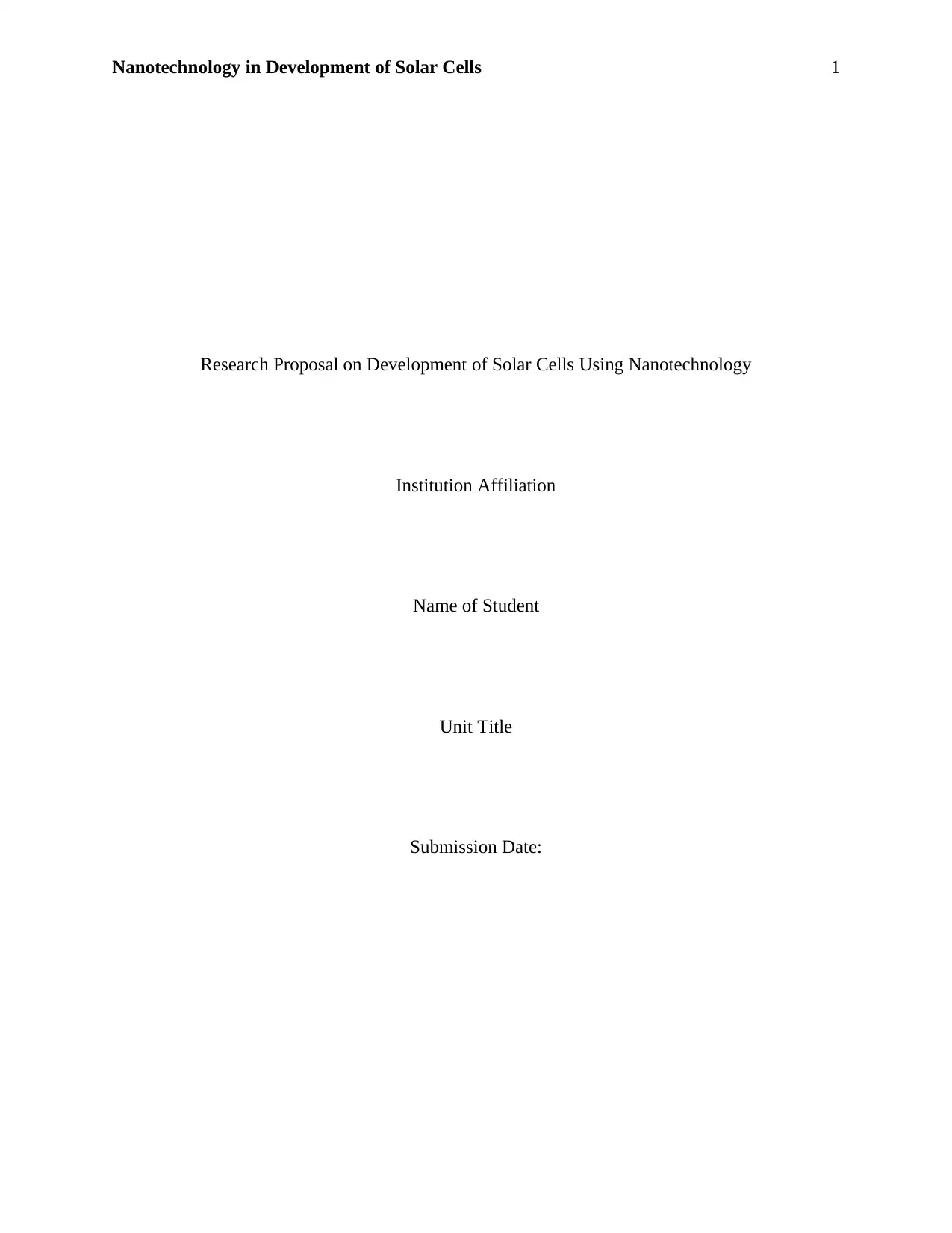
Nanotechnology in Development of Solar Cells 1
Research Proposal on Development of Solar Cells Using Nanotechnology
Institution Affiliation
Name of Student
Unit Title
Submission Date:
Research Proposal on Development of Solar Cells Using Nanotechnology
Institution Affiliation
Name of Student
Unit Title
Submission Date:
Paraphrase This Document
Need a fresh take? Get an instant paraphrase of this document with our AI Paraphraser

Nanotechnology in Development of Solar Cells 2
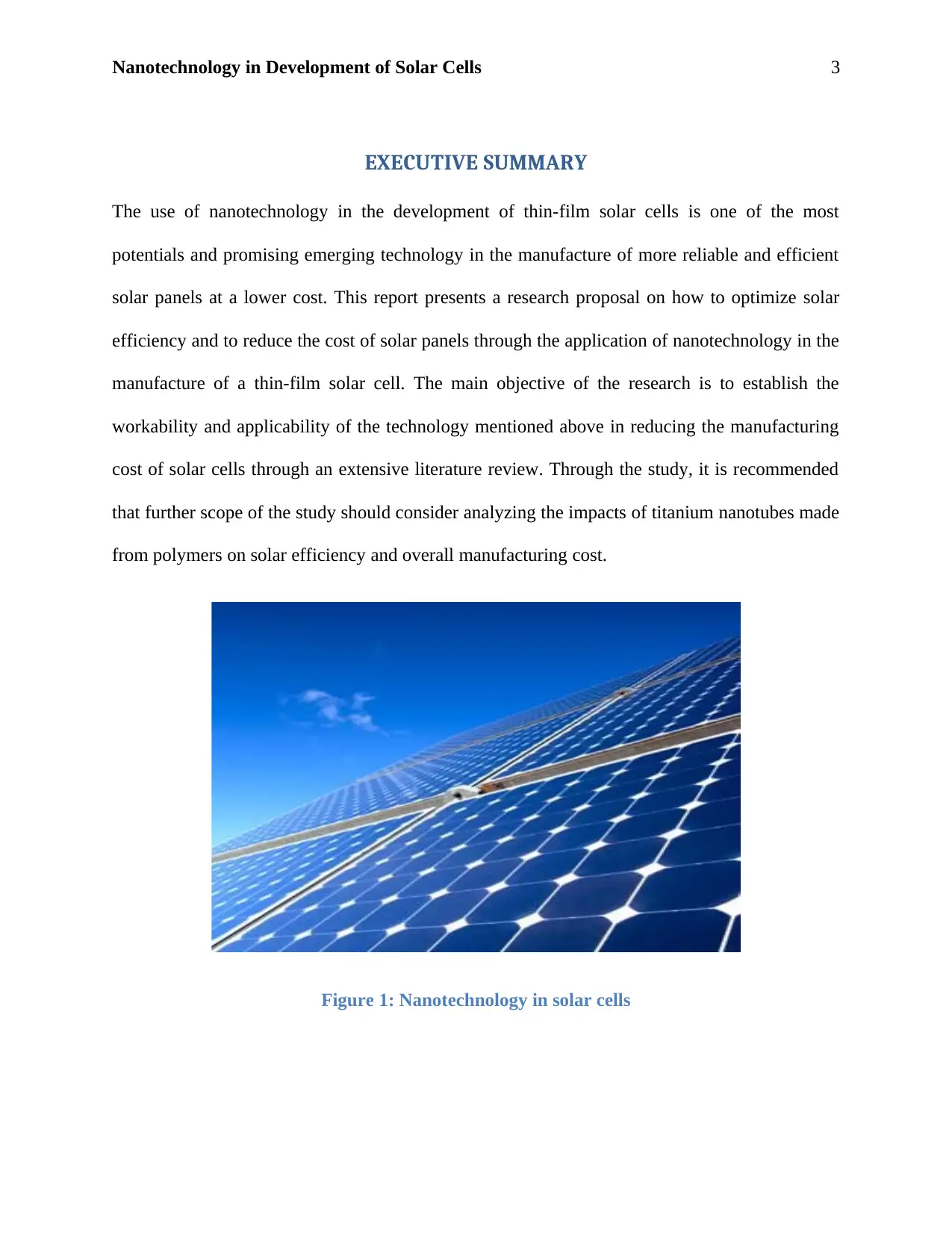
Nanotechnology in Development of Solar Cells 3
EXECUTIVE SUMMARY
The use of nanotechnology in the development of thin-film solar cells is one of the most
potentials and promising emerging technology in the manufacture of more reliable and efficient
solar panels at a lower cost. This report presents a research proposal on how to optimize solar
efficiency and to reduce the cost of solar panels through the application of nanotechnology in the
manufacture of a thin-film solar cell. The main objective of the research is to establish the
workability and applicability of the technology mentioned above in reducing the manufacturing
cost of solar cells through an extensive literature review. Through the study, it is recommended
that further scope of the study should consider analyzing the impacts of titanium nanotubes made
from polymers on solar efficiency and overall manufacturing cost.
Figure 1: Nanotechnology in solar cells
EXECUTIVE SUMMARY
The use of nanotechnology in the development of thin-film solar cells is one of the most
potentials and promising emerging technology in the manufacture of more reliable and efficient
solar panels at a lower cost. This report presents a research proposal on how to optimize solar
efficiency and to reduce the cost of solar panels through the application of nanotechnology in the
manufacture of a thin-film solar cell. The main objective of the research is to establish the
workability and applicability of the technology mentioned above in reducing the manufacturing
cost of solar cells through an extensive literature review. Through the study, it is recommended
that further scope of the study should consider analyzing the impacts of titanium nanotubes made
from polymers on solar efficiency and overall manufacturing cost.
Figure 1: Nanotechnology in solar cells
⊘ This is a preview!⊘
Do you want full access?
Subscribe today to unlock all pages.

Trusted by 1+ million students worldwide
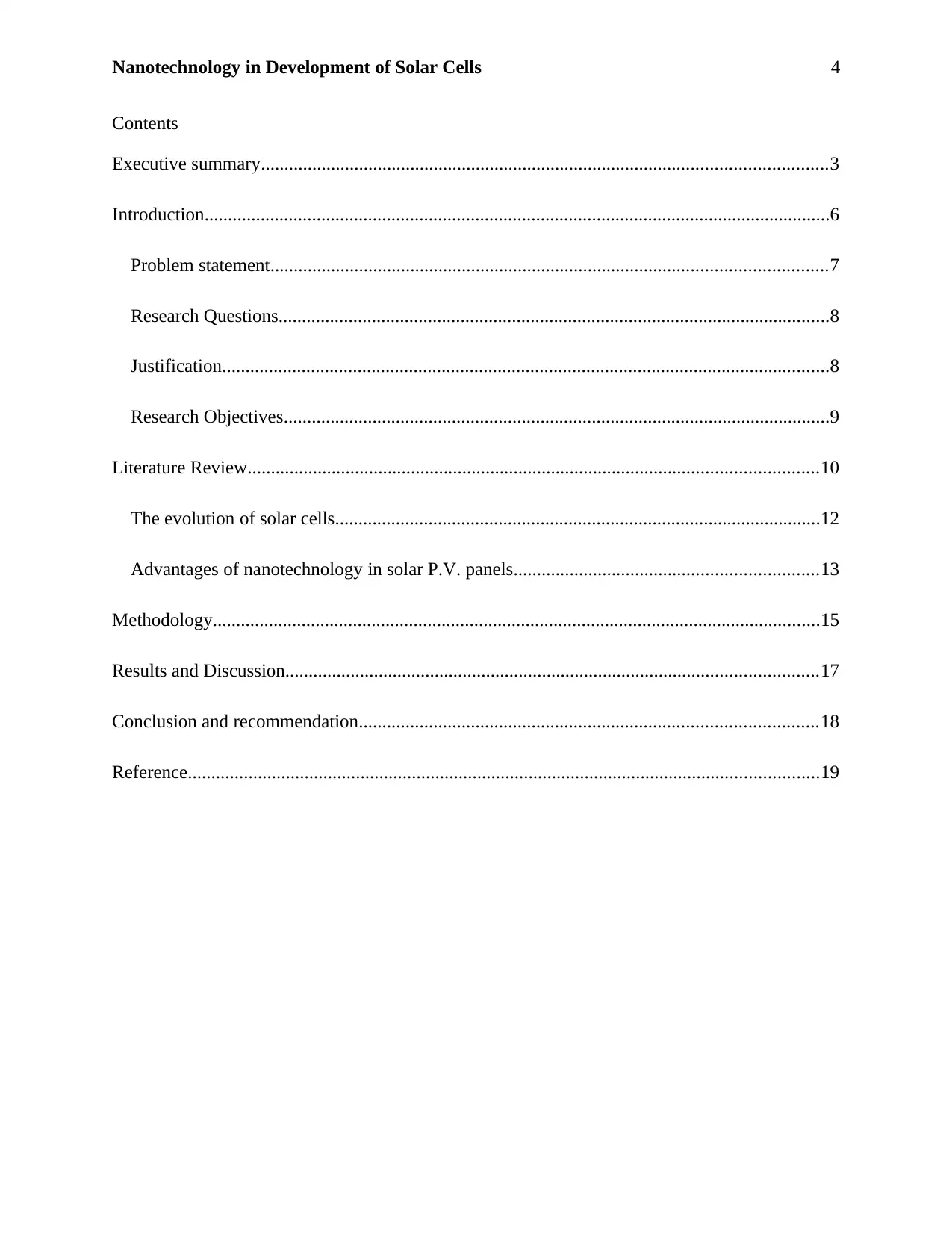
Nanotechnology in Development of Solar Cells 4
Contents
Executive summary.........................................................................................................................3
Introduction......................................................................................................................................6
Problem statement.......................................................................................................................7
Research Questions......................................................................................................................8
Justification..................................................................................................................................8
Research Objectives.....................................................................................................................9
Literature Review..........................................................................................................................10
The evolution of solar cells........................................................................................................12
Advantages of nanotechnology in solar P.V. panels.................................................................13
Methodology..................................................................................................................................15
Results and Discussion..................................................................................................................17
Conclusion and recommendation..................................................................................................18
Reference.......................................................................................................................................19
Contents
Executive summary.........................................................................................................................3
Introduction......................................................................................................................................6
Problem statement.......................................................................................................................7
Research Questions......................................................................................................................8
Justification..................................................................................................................................8
Research Objectives.....................................................................................................................9
Literature Review..........................................................................................................................10
The evolution of solar cells........................................................................................................12
Advantages of nanotechnology in solar P.V. panels.................................................................13
Methodology..................................................................................................................................15
Results and Discussion..................................................................................................................17
Conclusion and recommendation..................................................................................................18
Reference.......................................................................................................................................19
Paraphrase This Document
Need a fresh take? Get an instant paraphrase of this document with our AI Paraphraser
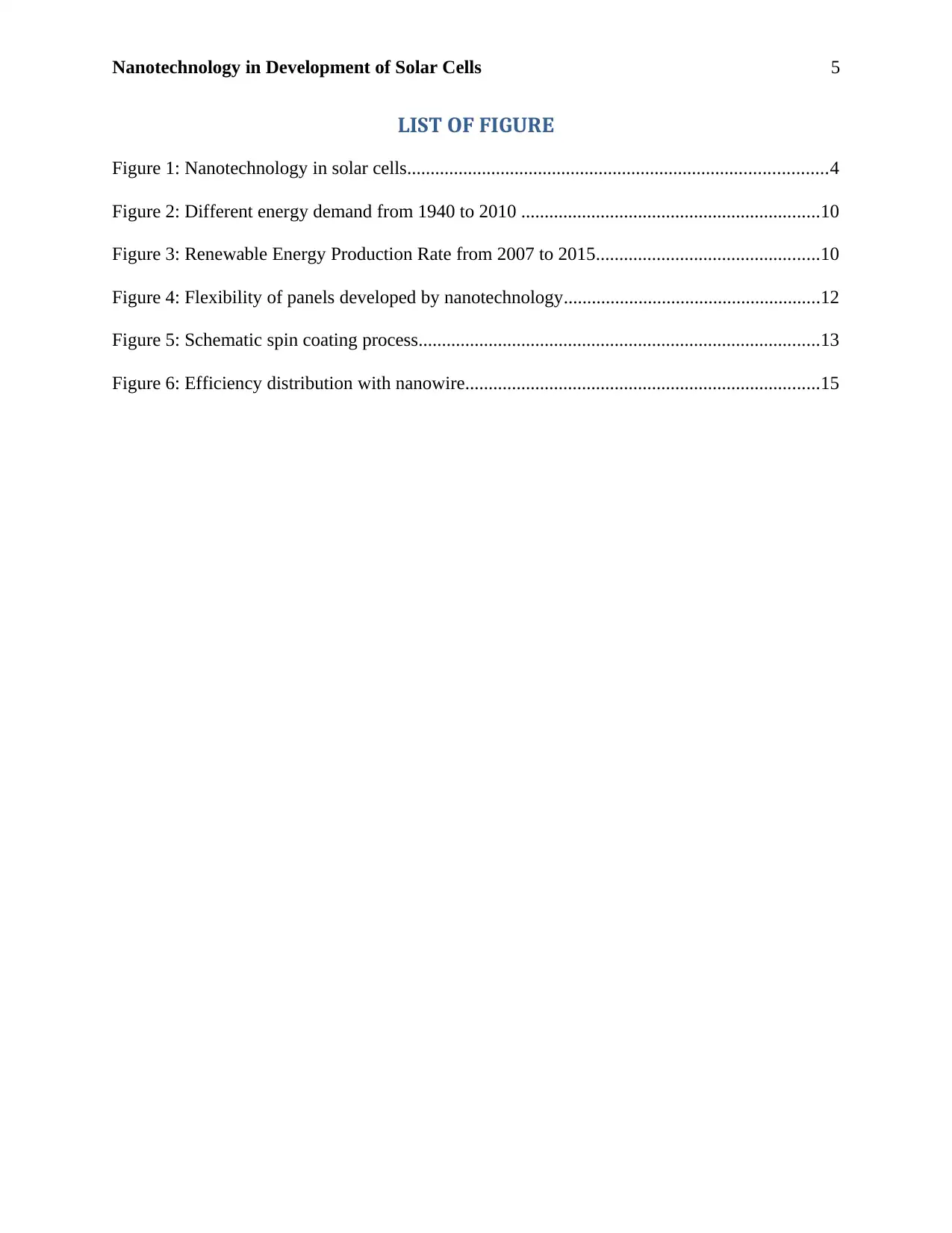
Nanotechnology in Development of Solar Cells 5
LIST OF FIGURE
Figure 1: Nanotechnology in solar cells..........................................................................................4
Figure 2: Different energy demand from 1940 to 2010 ................................................................10
Figure 3: Renewable Energy Production Rate from 2007 to 2015................................................10
Figure 4: Flexibility of panels developed by nanotechnology.......................................................12
Figure 5: Schematic spin coating process......................................................................................13
Figure 6: Efficiency distribution with nanowire............................................................................15
LIST OF FIGURE
Figure 1: Nanotechnology in solar cells..........................................................................................4
Figure 2: Different energy demand from 1940 to 2010 ................................................................10
Figure 3: Renewable Energy Production Rate from 2007 to 2015................................................10
Figure 4: Flexibility of panels developed by nanotechnology.......................................................12
Figure 5: Schematic spin coating process......................................................................................13
Figure 6: Efficiency distribution with nanowire............................................................................15
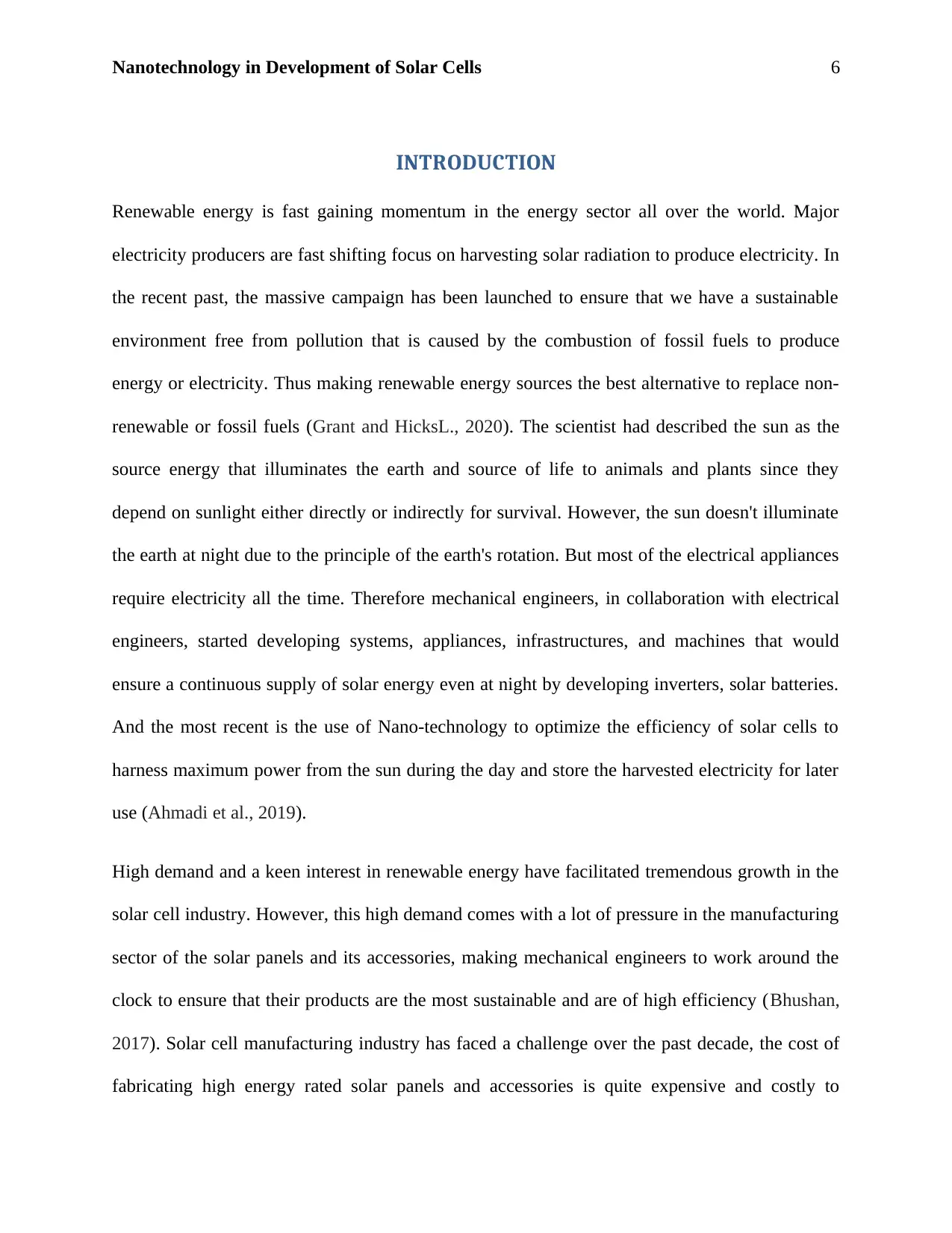
Nanotechnology in Development of Solar Cells 6
INTRODUCTION
Renewable energy is fast gaining momentum in the energy sector all over the world. Major
electricity producers are fast shifting focus on harvesting solar radiation to produce electricity. In
the recent past, the massive campaign has been launched to ensure that we have a sustainable
environment free from pollution that is caused by the combustion of fossil fuels to produce
energy or electricity. Thus making renewable energy sources the best alternative to replace non-
renewable or fossil fuels (Grant and HicksL., 2020). The scientist had described the sun as the
source energy that illuminates the earth and source of life to animals and plants since they
depend on sunlight either directly or indirectly for survival. However, the sun doesn't illuminate
the earth at night due to the principle of the earth's rotation. But most of the electrical appliances
require electricity all the time. Therefore mechanical engineers, in collaboration with electrical
engineers, started developing systems, appliances, infrastructures, and machines that would
ensure a continuous supply of solar energy even at night by developing inverters, solar batteries.
And the most recent is the use of Nano-technology to optimize the efficiency of solar cells to
harness maximum power from the sun during the day and store the harvested electricity for later
use (Ahmadi et al., 2019).
High demand and a keen interest in renewable energy have facilitated tremendous growth in the
solar cell industry. However, this high demand comes with a lot of pressure in the manufacturing
sector of the solar panels and its accessories, making mechanical engineers to work around the
clock to ensure that their products are the most sustainable and are of high efficiency (Bhushan,
2017). Solar cell manufacturing industry has faced a challenge over the past decade, the cost of
fabricating high energy rated solar panels and accessories is quite expensive and costly to
INTRODUCTION
Renewable energy is fast gaining momentum in the energy sector all over the world. Major
electricity producers are fast shifting focus on harvesting solar radiation to produce electricity. In
the recent past, the massive campaign has been launched to ensure that we have a sustainable
environment free from pollution that is caused by the combustion of fossil fuels to produce
energy or electricity. Thus making renewable energy sources the best alternative to replace non-
renewable or fossil fuels (Grant and HicksL., 2020). The scientist had described the sun as the
source energy that illuminates the earth and source of life to animals and plants since they
depend on sunlight either directly or indirectly for survival. However, the sun doesn't illuminate
the earth at night due to the principle of the earth's rotation. But most of the electrical appliances
require electricity all the time. Therefore mechanical engineers, in collaboration with electrical
engineers, started developing systems, appliances, infrastructures, and machines that would
ensure a continuous supply of solar energy even at night by developing inverters, solar batteries.
And the most recent is the use of Nano-technology to optimize the efficiency of solar cells to
harness maximum power from the sun during the day and store the harvested electricity for later
use (Ahmadi et al., 2019).
High demand and a keen interest in renewable energy have facilitated tremendous growth in the
solar cell industry. However, this high demand comes with a lot of pressure in the manufacturing
sector of the solar panels and its accessories, making mechanical engineers to work around the
clock to ensure that their products are the most sustainable and are of high efficiency (Bhushan,
2017). Solar cell manufacturing industry has faced a challenge over the past decade, the cost of
fabricating high energy rated solar panels and accessories is quite expensive and costly to
⊘ This is a preview!⊘
Do you want full access?
Subscribe today to unlock all pages.

Trusted by 1+ million students worldwide
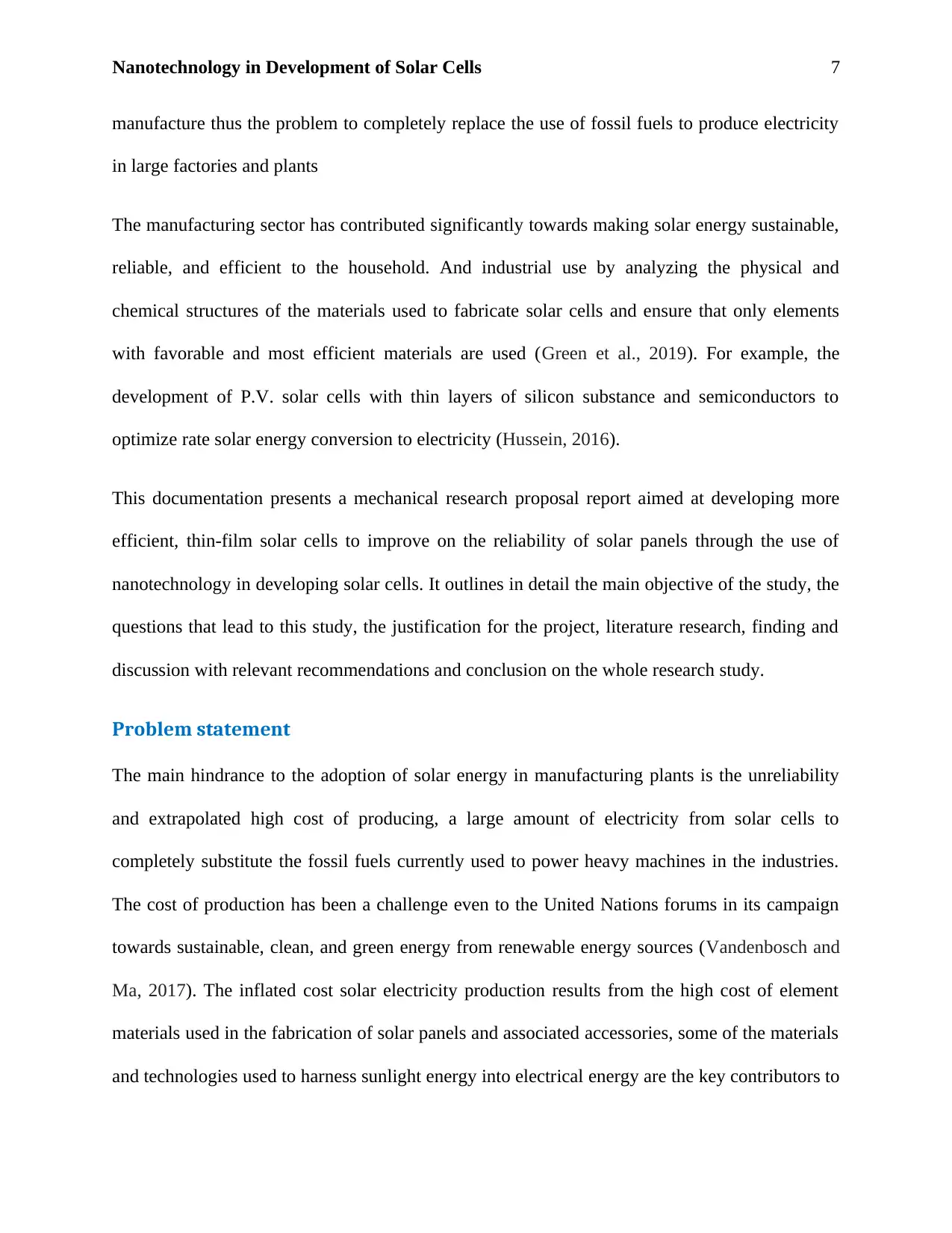
Nanotechnology in Development of Solar Cells 7
manufacture thus the problem to completely replace the use of fossil fuels to produce electricity
in large factories and plants
The manufacturing sector has contributed significantly towards making solar energy sustainable,
reliable, and efficient to the household. And industrial use by analyzing the physical and
chemical structures of the materials used to fabricate solar cells and ensure that only elements
with favorable and most efficient materials are used (Green et al., 2019). For example, the
development of P.V. solar cells with thin layers of silicon substance and semiconductors to
optimize rate solar energy conversion to electricity (Hussein, 2016).
This documentation presents a mechanical research proposal report aimed at developing more
efficient, thin-film solar cells to improve on the reliability of solar panels through the use of
nanotechnology in developing solar cells. It outlines in detail the main objective of the study, the
questions that lead to this study, the justification for the project, literature research, finding and
discussion with relevant recommendations and conclusion on the whole research study.
Problem statement
The main hindrance to the adoption of solar energy in manufacturing plants is the unreliability
and extrapolated high cost of producing, a large amount of electricity from solar cells to
completely substitute the fossil fuels currently used to power heavy machines in the industries.
The cost of production has been a challenge even to the United Nations forums in its campaign
towards sustainable, clean, and green energy from renewable energy sources (Vandenbosch and
Ma, 2017). The inflated cost solar electricity production results from the high cost of element
materials used in the fabrication of solar panels and associated accessories, some of the materials
and technologies used to harness sunlight energy into electrical energy are the key contributors to
manufacture thus the problem to completely replace the use of fossil fuels to produce electricity
in large factories and plants
The manufacturing sector has contributed significantly towards making solar energy sustainable,
reliable, and efficient to the household. And industrial use by analyzing the physical and
chemical structures of the materials used to fabricate solar cells and ensure that only elements
with favorable and most efficient materials are used (Green et al., 2019). For example, the
development of P.V. solar cells with thin layers of silicon substance and semiconductors to
optimize rate solar energy conversion to electricity (Hussein, 2016).
This documentation presents a mechanical research proposal report aimed at developing more
efficient, thin-film solar cells to improve on the reliability of solar panels through the use of
nanotechnology in developing solar cells. It outlines in detail the main objective of the study, the
questions that lead to this study, the justification for the project, literature research, finding and
discussion with relevant recommendations and conclusion on the whole research study.
Problem statement
The main hindrance to the adoption of solar energy in manufacturing plants is the unreliability
and extrapolated high cost of producing, a large amount of electricity from solar cells to
completely substitute the fossil fuels currently used to power heavy machines in the industries.
The cost of production has been a challenge even to the United Nations forums in its campaign
towards sustainable, clean, and green energy from renewable energy sources (Vandenbosch and
Ma, 2017). The inflated cost solar electricity production results from the high cost of element
materials used in the fabrication of solar panels and associated accessories, some of the materials
and technologies used to harness sunlight energy into electrical energy are the key contributors to
Paraphrase This Document
Need a fresh take? Get an instant paraphrase of this document with our AI Paraphraser
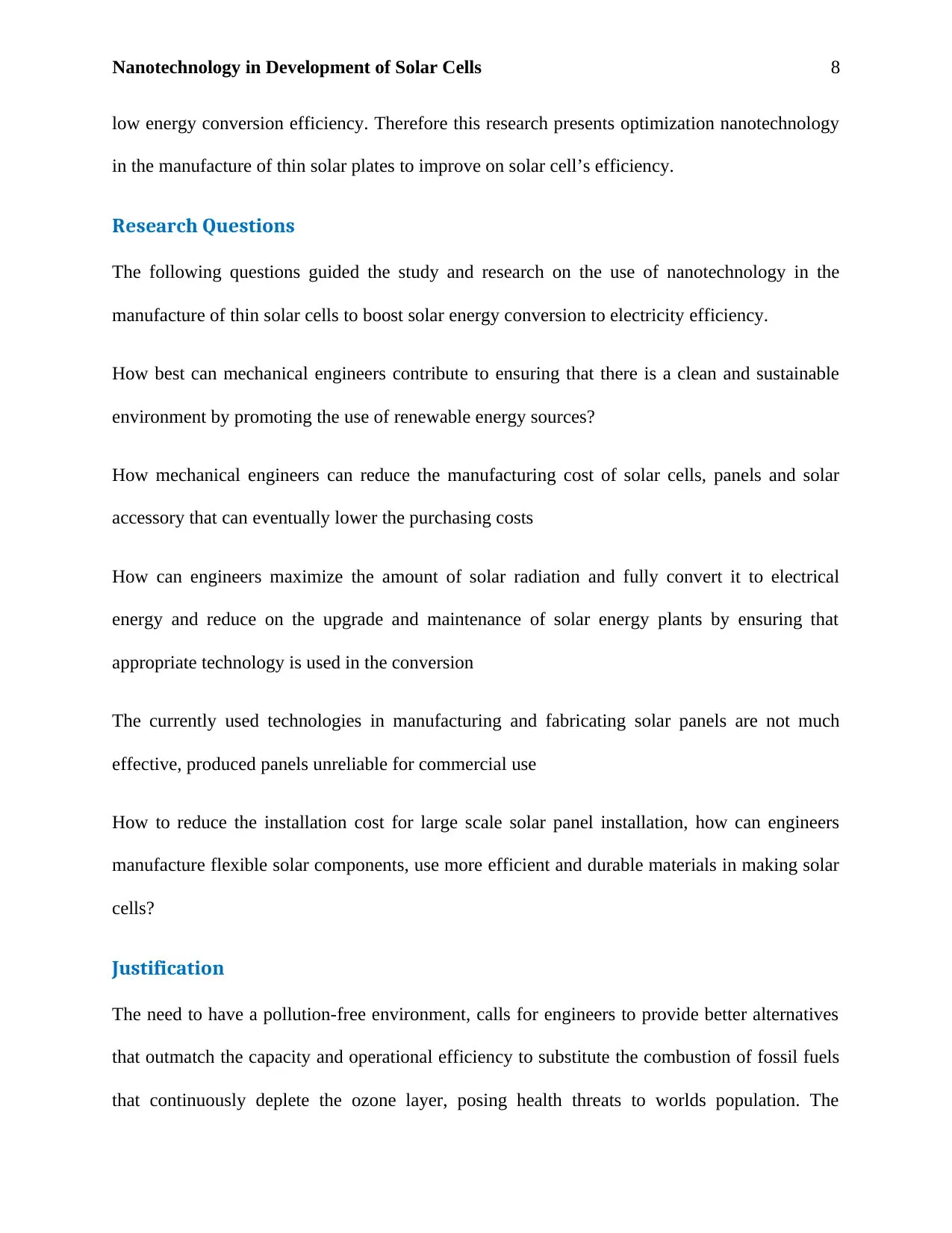
Nanotechnology in Development of Solar Cells 8
low energy conversion efficiency. Therefore this research presents optimization nanotechnology
in the manufacture of thin solar plates to improve on solar cell’s efficiency.
Research Questions
The following questions guided the study and research on the use of nanotechnology in the
manufacture of thin solar cells to boost solar energy conversion to electricity efficiency.
How best can mechanical engineers contribute to ensuring that there is a clean and sustainable
environment by promoting the use of renewable energy sources?
How mechanical engineers can reduce the manufacturing cost of solar cells, panels and solar
accessory that can eventually lower the purchasing costs
How can engineers maximize the amount of solar radiation and fully convert it to electrical
energy and reduce on the upgrade and maintenance of solar energy plants by ensuring that
appropriate technology is used in the conversion
The currently used technologies in manufacturing and fabricating solar panels are not much
effective, produced panels unreliable for commercial use
How to reduce the installation cost for large scale solar panel installation, how can engineers
manufacture flexible solar components, use more efficient and durable materials in making solar
cells?
Justification
The need to have a pollution-free environment, calls for engineers to provide better alternatives
that outmatch the capacity and operational efficiency to substitute the combustion of fossil fuels
that continuously deplete the ozone layer, posing health threats to worlds population. The
low energy conversion efficiency. Therefore this research presents optimization nanotechnology
in the manufacture of thin solar plates to improve on solar cell’s efficiency.
Research Questions
The following questions guided the study and research on the use of nanotechnology in the
manufacture of thin solar cells to boost solar energy conversion to electricity efficiency.
How best can mechanical engineers contribute to ensuring that there is a clean and sustainable
environment by promoting the use of renewable energy sources?
How mechanical engineers can reduce the manufacturing cost of solar cells, panels and solar
accessory that can eventually lower the purchasing costs
How can engineers maximize the amount of solar radiation and fully convert it to electrical
energy and reduce on the upgrade and maintenance of solar energy plants by ensuring that
appropriate technology is used in the conversion
The currently used technologies in manufacturing and fabricating solar panels are not much
effective, produced panels unreliable for commercial use
How to reduce the installation cost for large scale solar panel installation, how can engineers
manufacture flexible solar components, use more efficient and durable materials in making solar
cells?
Justification
The need to have a pollution-free environment, calls for engineers to provide better alternatives
that outmatch the capacity and operational efficiency to substitute the combustion of fossil fuels
that continuously deplete the ozone layer, posing health threats to worlds population. The
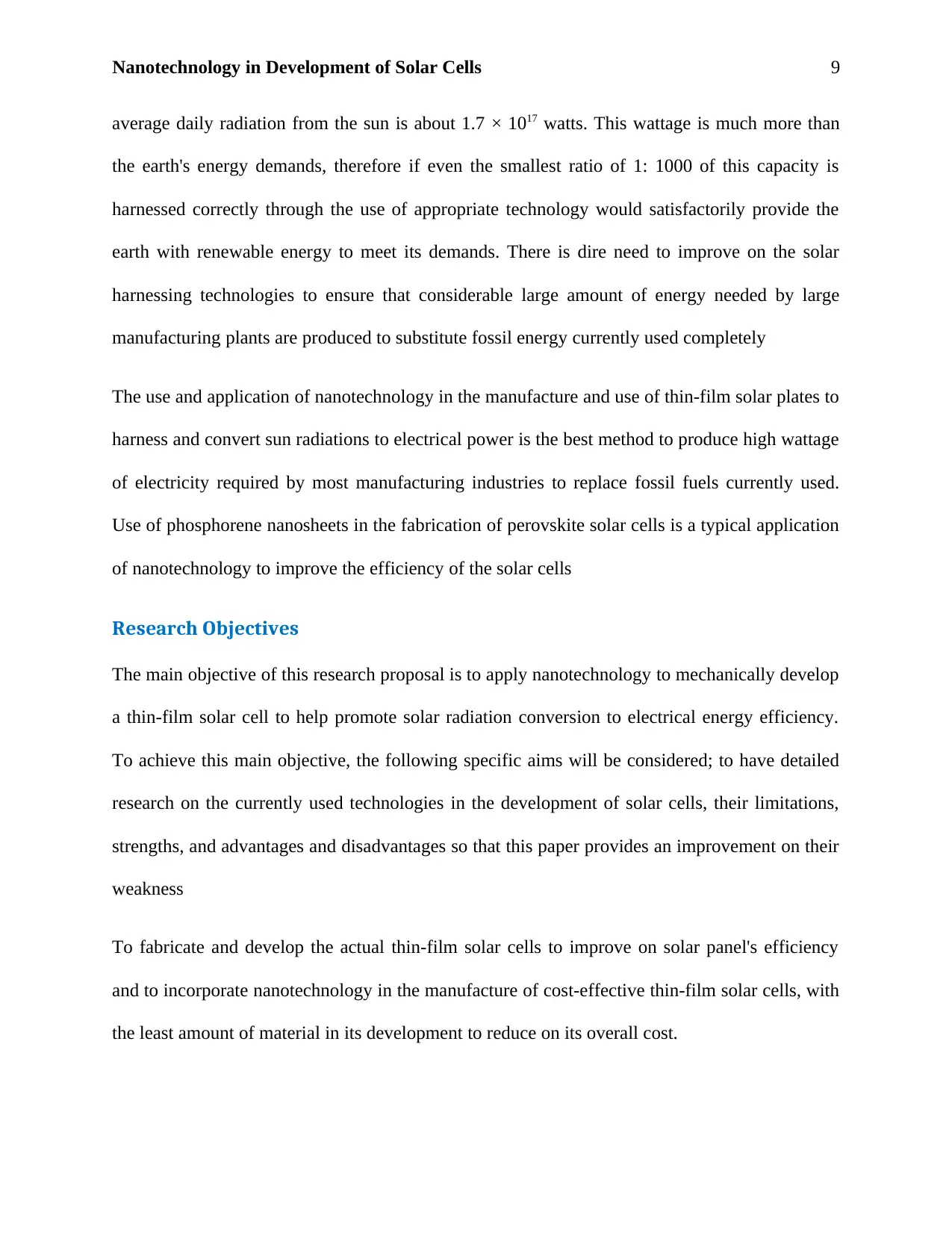
Nanotechnology in Development of Solar Cells 9
average daily radiation from the sun is about 1.7 × 1017 watts. This wattage is much more than
the earth's energy demands, therefore if even the smallest ratio of 1: 1000 of this capacity is
harnessed correctly through the use of appropriate technology would satisfactorily provide the
earth with renewable energy to meet its demands. There is dire need to improve on the solar
harnessing technologies to ensure that considerable large amount of energy needed by large
manufacturing plants are produced to substitute fossil energy currently used completely
The use and application of nanotechnology in the manufacture and use of thin-film solar plates to
harness and convert sun radiations to electrical power is the best method to produce high wattage
of electricity required by most manufacturing industries to replace fossil fuels currently used.
Use of phosphorene nanosheets in the fabrication of perovskite solar cells is a typical application
of nanotechnology to improve the efficiency of the solar cells
Research Objectives
The main objective of this research proposal is to apply nanotechnology to mechanically develop
a thin-film solar cell to help promote solar radiation conversion to electrical energy efficiency.
To achieve this main objective, the following specific aims will be considered; to have detailed
research on the currently used technologies in the development of solar cells, their limitations,
strengths, and advantages and disadvantages so that this paper provides an improvement on their
weakness
To fabricate and develop the actual thin-film solar cells to improve on solar panel's efficiency
and to incorporate nanotechnology in the manufacture of cost-effective thin-film solar cells, with
the least amount of material in its development to reduce on its overall cost.
average daily radiation from the sun is about 1.7 × 1017 watts. This wattage is much more than
the earth's energy demands, therefore if even the smallest ratio of 1: 1000 of this capacity is
harnessed correctly through the use of appropriate technology would satisfactorily provide the
earth with renewable energy to meet its demands. There is dire need to improve on the solar
harnessing technologies to ensure that considerable large amount of energy needed by large
manufacturing plants are produced to substitute fossil energy currently used completely
The use and application of nanotechnology in the manufacture and use of thin-film solar plates to
harness and convert sun radiations to electrical power is the best method to produce high wattage
of electricity required by most manufacturing industries to replace fossil fuels currently used.
Use of phosphorene nanosheets in the fabrication of perovskite solar cells is a typical application
of nanotechnology to improve the efficiency of the solar cells
Research Objectives
The main objective of this research proposal is to apply nanotechnology to mechanically develop
a thin-film solar cell to help promote solar radiation conversion to electrical energy efficiency.
To achieve this main objective, the following specific aims will be considered; to have detailed
research on the currently used technologies in the development of solar cells, their limitations,
strengths, and advantages and disadvantages so that this paper provides an improvement on their
weakness
To fabricate and develop the actual thin-film solar cells to improve on solar panel's efficiency
and to incorporate nanotechnology in the manufacture of cost-effective thin-film solar cells, with
the least amount of material in its development to reduce on its overall cost.
⊘ This is a preview!⊘
Do you want full access?
Subscribe today to unlock all pages.

Trusted by 1+ million students worldwide
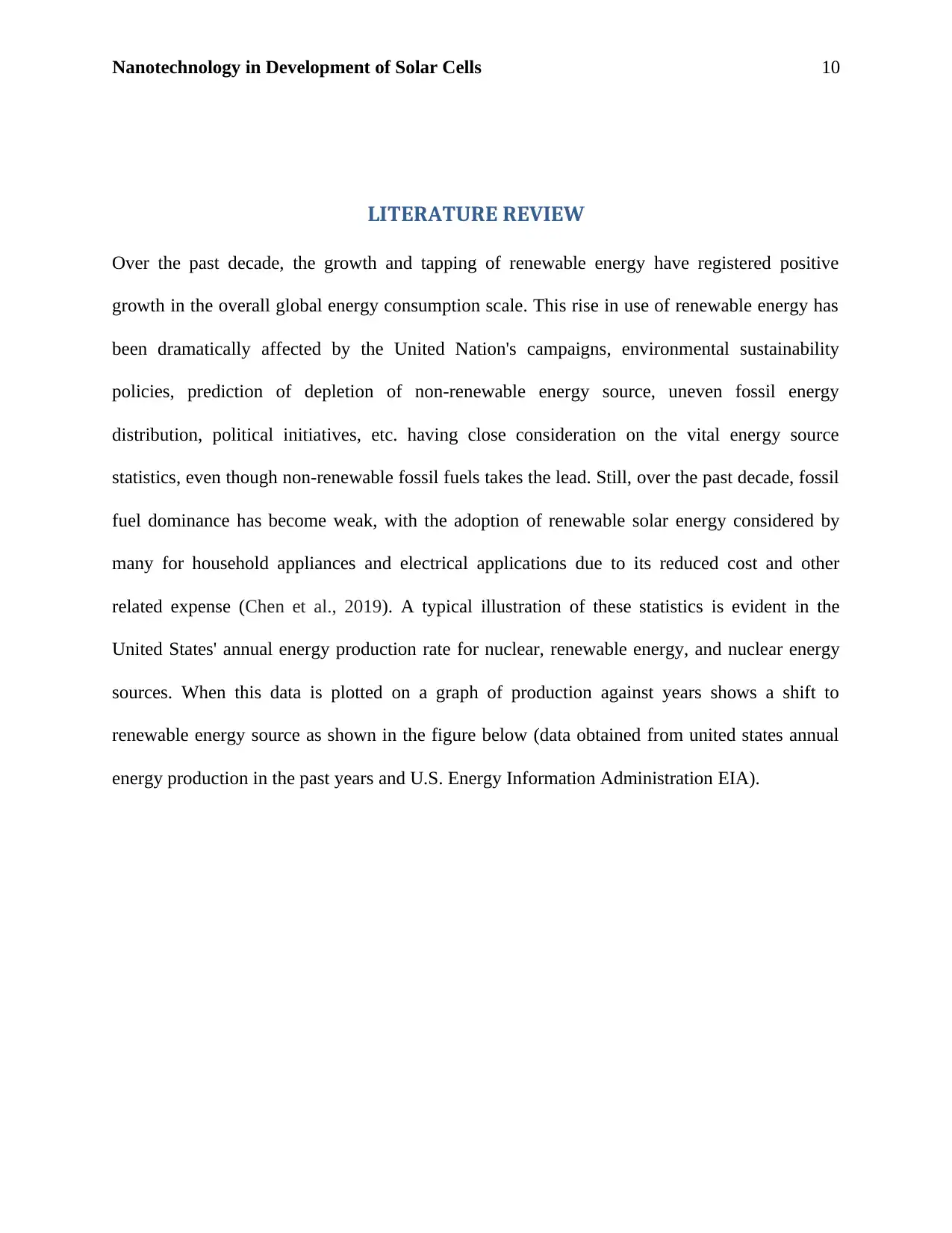
Nanotechnology in Development of Solar Cells 10
LITERATURE REVIEW
Over the past decade, the growth and tapping of renewable energy have registered positive
growth in the overall global energy consumption scale. This rise in use of renewable energy has
been dramatically affected by the United Nation's campaigns, environmental sustainability
policies, prediction of depletion of non-renewable energy source, uneven fossil energy
distribution, political initiatives, etc. having close consideration on the vital energy source
statistics, even though non-renewable fossil fuels takes the lead. Still, over the past decade, fossil
fuel dominance has become weak, with the adoption of renewable solar energy considered by
many for household appliances and electrical applications due to its reduced cost and other
related expense (Chen et al., 2019). A typical illustration of these statistics is evident in the
United States' annual energy production rate for nuclear, renewable energy, and nuclear energy
sources. When this data is plotted on a graph of production against years shows a shift to
renewable energy source as shown in the figure below (data obtained from united states annual
energy production in the past years and U.S. Energy Information Administration EIA).
LITERATURE REVIEW
Over the past decade, the growth and tapping of renewable energy have registered positive
growth in the overall global energy consumption scale. This rise in use of renewable energy has
been dramatically affected by the United Nation's campaigns, environmental sustainability
policies, prediction of depletion of non-renewable energy source, uneven fossil energy
distribution, political initiatives, etc. having close consideration on the vital energy source
statistics, even though non-renewable fossil fuels takes the lead. Still, over the past decade, fossil
fuel dominance has become weak, with the adoption of renewable solar energy considered by
many for household appliances and electrical applications due to its reduced cost and other
related expense (Chen et al., 2019). A typical illustration of these statistics is evident in the
United States' annual energy production rate for nuclear, renewable energy, and nuclear energy
sources. When this data is plotted on a graph of production against years shows a shift to
renewable energy source as shown in the figure below (data obtained from united states annual
energy production in the past years and U.S. Energy Information Administration EIA).
Paraphrase This Document
Need a fresh take? Get an instant paraphrase of this document with our AI Paraphraser
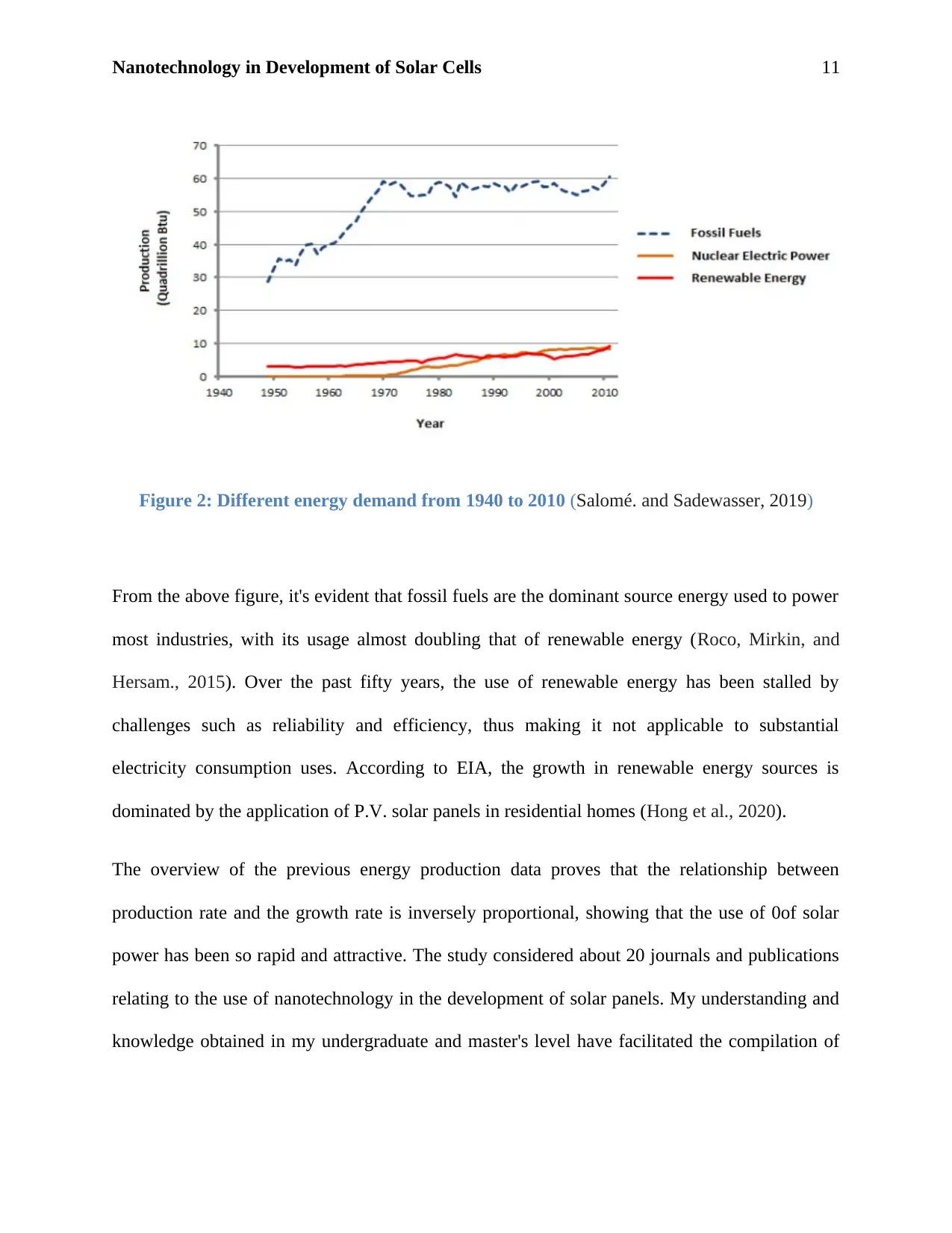
Nanotechnology in Development of Solar Cells 11
Figure 2: Different energy demand from 1940 to 2010 (Salomé. and Sadewasser, 2019)
From the above figure, it's evident that fossil fuels are the dominant source energy used to power
most industries, with its usage almost doubling that of renewable energy (Roco, Mirkin, and
Hersam., 2015). Over the past fifty years, the use of renewable energy has been stalled by
challenges such as reliability and efficiency, thus making it not applicable to substantial
electricity consumption uses. According to EIA, the growth in renewable energy sources is
dominated by the application of P.V. solar panels in residential homes (Hong et al., 2020).
The overview of the previous energy production data proves that the relationship between
production rate and the growth rate is inversely proportional, showing that the use of 0of solar
power has been so rapid and attractive. The study considered about 20 journals and publications
relating to the use of nanotechnology in the development of solar panels. My understanding and
knowledge obtained in my undergraduate and master's level have facilitated the compilation of
Figure 2: Different energy demand from 1940 to 2010 (Salomé. and Sadewasser, 2019)
From the above figure, it's evident that fossil fuels are the dominant source energy used to power
most industries, with its usage almost doubling that of renewable energy (Roco, Mirkin, and
Hersam., 2015). Over the past fifty years, the use of renewable energy has been stalled by
challenges such as reliability and efficiency, thus making it not applicable to substantial
electricity consumption uses. According to EIA, the growth in renewable energy sources is
dominated by the application of P.V. solar panels in residential homes (Hong et al., 2020).
The overview of the previous energy production data proves that the relationship between
production rate and the growth rate is inversely proportional, showing that the use of 0of solar
power has been so rapid and attractive. The study considered about 20 journals and publications
relating to the use of nanotechnology in the development of solar panels. My understanding and
knowledge obtained in my undergraduate and master's level have facilitated the compilation of
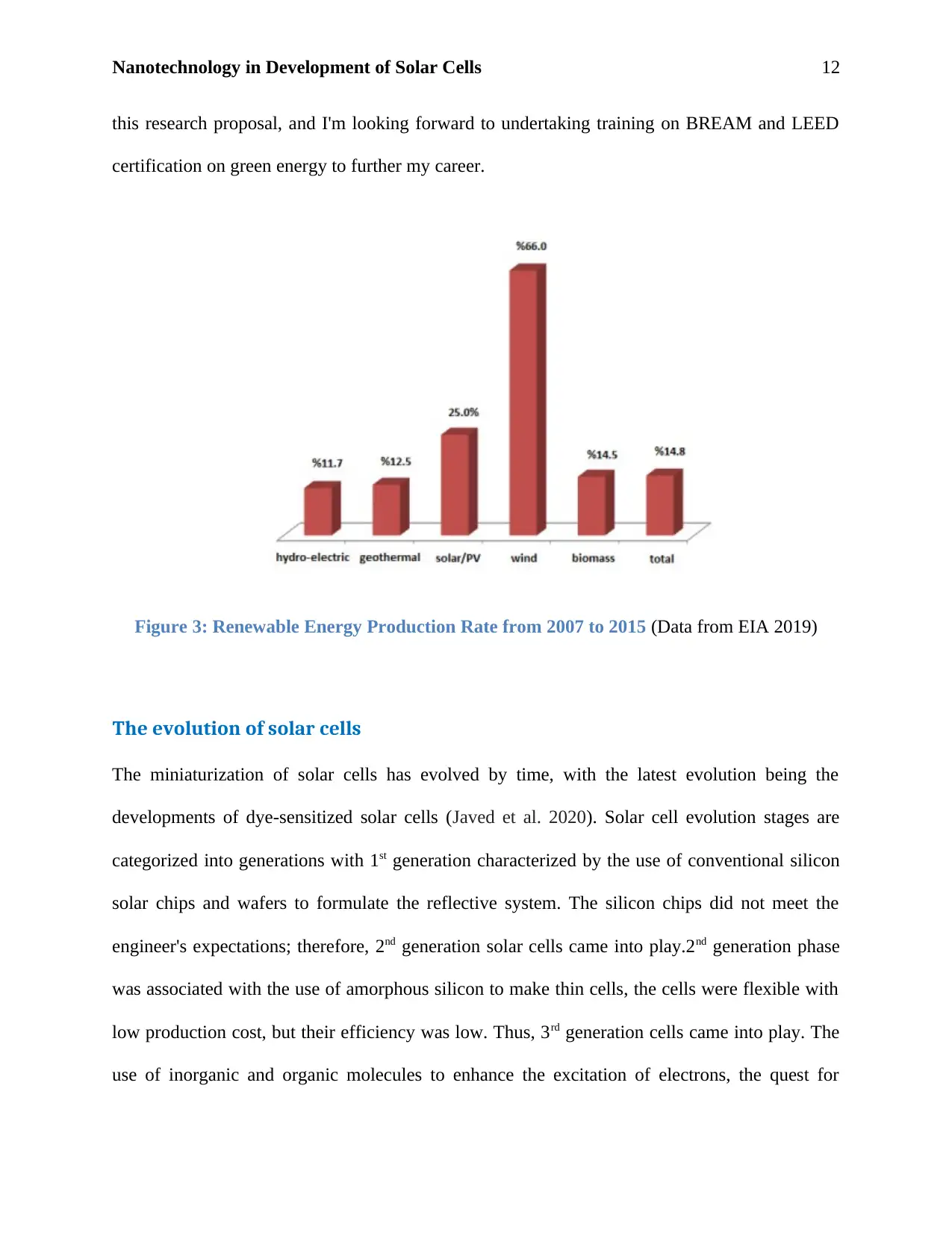
Nanotechnology in Development of Solar Cells 12
this research proposal, and I'm looking forward to undertaking training on BREAM and LEED
certification on green energy to further my career.
Figure 3: Renewable Energy Production Rate from 2007 to 2015 (Data from EIA 2019)
The evolution of solar cells
The miniaturization of solar cells has evolved by time, with the latest evolution being the
developments of dye-sensitized solar cells (Javed et al. 2020). Solar cell evolution stages are
categorized into generations with 1st generation characterized by the use of conventional silicon
solar chips and wafers to formulate the reflective system. The silicon chips did not meet the
engineer's expectations; therefore, 2nd generation solar cells came into play.2nd generation phase
was associated with the use of amorphous silicon to make thin cells, the cells were flexible with
low production cost, but their efficiency was low. Thus, 3rd generation cells came into play. The
use of inorganic and organic molecules to enhance the excitation of electrons, the quest for
this research proposal, and I'm looking forward to undertaking training on BREAM and LEED
certification on green energy to further my career.
Figure 3: Renewable Energy Production Rate from 2007 to 2015 (Data from EIA 2019)
The evolution of solar cells
The miniaturization of solar cells has evolved by time, with the latest evolution being the
developments of dye-sensitized solar cells (Javed et al. 2020). Solar cell evolution stages are
categorized into generations with 1st generation characterized by the use of conventional silicon
solar chips and wafers to formulate the reflective system. The silicon chips did not meet the
engineer's expectations; therefore, 2nd generation solar cells came into play.2nd generation phase
was associated with the use of amorphous silicon to make thin cells, the cells were flexible with
low production cost, but their efficiency was low. Thus, 3rd generation cells came into play. The
use of inorganic and organic molecules to enhance the excitation of electrons, the quest for
⊘ This is a preview!⊘
Do you want full access?
Subscribe today to unlock all pages.

Trusted by 1+ million students worldwide
1 out of 21
Related Documents
Your All-in-One AI-Powered Toolkit for Academic Success.
+13062052269
info@desklib.com
Available 24*7 on WhatsApp / Email
![[object Object]](/_next/static/media/star-bottom.7253800d.svg)
Unlock your academic potential
Copyright © 2020–2025 A2Z Services. All Rights Reserved. Developed and managed by ZUCOL.



